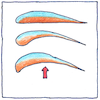Daniel Bernoulli
physics

|
Bernoulli’s principle
Liquids and gases increasing in motion have the energy of their increase subtracted from their pressure controlling the flow of fuel into a carburetor and lifting the wing of an airplane so that the sum of all forms of energy remains constant.
Sailing
Some might think a wind, filling a sail, pushes the boat, but this is not so. The sail is only a flexible airfoil whose curve forces the air passing on one side to flow more quickly than the air passing on the other, so that the increase in speed is compensated by a decrease in pressure that pulls the boat through the sea, even against the wind.
Cutting through to the essence
Bernoulli’s principle, stated for an ideal fluid— with no viscosity, no drag, and no compressibility, is true enough to help with understanding, true enough to lift an airplane even though all kinds of odd things happen as air swirls past.



Wilbur and Orville Wright demonstrated heavier-than-air, controlled flight in 1903. Before this, in 1901, they built a wind tunnel to improve the shape of their wings. Possibly the first person to realize that Bernoulli’s principle explains the lift of an airplane wing was Edward Chalmers Huffaker, in a letter to Samuel Pierpont Langley in 1893. In 1895, Wilbur and Orville Wright obtained a copies of publications related to flight, including a paper by Huffaker, from the Smithsonian Institution. In 1911, Gustave Eiffel proved that Bernoulli’s principle was responsible for the lift produced by an airfoil.
See also in The book of science:
Readings in wikipedia: